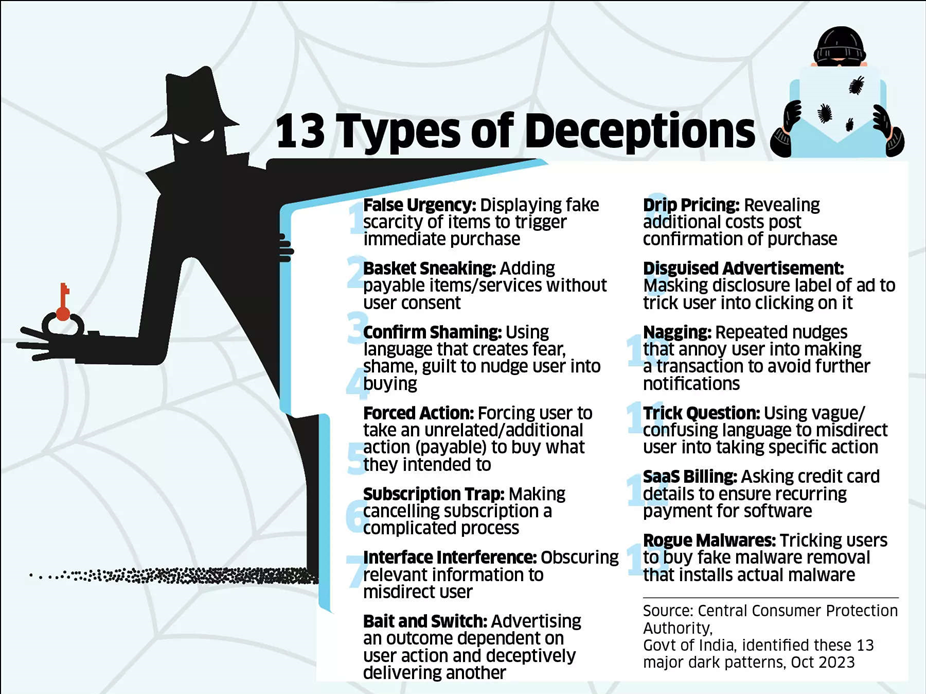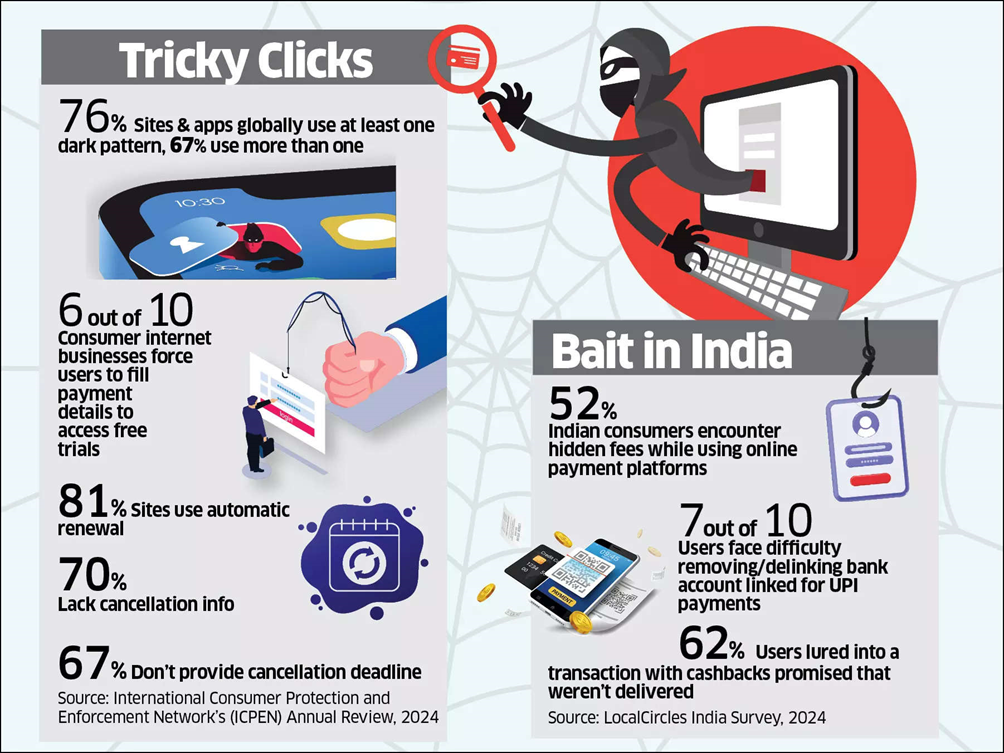WEB OF LIES: HOW CONSUMERS ARE TURNING CAUTIOUS AS INTERNET COMPANIES USE DARK PATTERNS
Relevance: GS 3 – Awareness in the fields of IT
Why in the News?
- More consumer internet companies are using sneaky tactics such as hidden fees and tricky subscriptions.
- Users are feeling stressed and cautious when using everyday apps for convenience.
- These apps, initially meant to make life easier, now come with annoying surprises.
- According to the International Consumer Protection and Enforcement Network (ICPEN):
- At least 76% of sites and apps worldwide use at least one dark pattern.
- 67% of these sites and apps use more than one dark pattern.
What is a Dark Pattern?
- It refers to manipulative or deceptive tricks used on digital platforms such as hidden fees, subscription traps, and sneaking items into online baskets.
- Designed to get users to perform actions they wouldn’t have done if they understood the situation or had a choice.
- Term coined in 2010 by Harry Brignull, a UK-based UX (user experience) designer.
- Common Dark Pattern Tactics:
- False Urgency: Ecommerce sites display fake scarcity to trigger quick purchases. Example: Sites display messages like “Only two items left in stock” to prompt immediate purchases.
Dark Patterns in Consumer Internet Apps
- Common apps affected include ecommerce, food and grocery delivery, cab services, and online travel aggregators.
- Popularity vs. Nuisance: Consumer internet apps were popularized for convenience but now often present nuisances.
-
- Recent ICPEN report:
- 76% of sites and apps globally use at least one dark pattern.
- 67% use more than one.
- CCPA’s Findings (October 2023) Identified 13 dark patterns, including:
- False Urgency: Artificially creating a sense of urgency.
- Basket Sneaking: Adding items to the cart without user consent.
- Confirm Shaming: Using guilt-inducing language to push purchases, e.g., “I’ll risk my safety and family’s” for insurance during flight bookings.
- Forced Action: Requires users to enter credit card details to access free trials.
- According to the ICPEN report, 60% of consumer internet businesses use this tactic.
- Subscription Traps: Complicate the cancellation process.
- 81% of sites use automatic subscription renewal.
- 70% of sites lack clear information on how to cancel subscriptions.
- Recent ICPEN report:
Consumer Experience:
- Akshit Rajpal, a media and entertainment lawyer from Mumbai, finds the online shopping experience increasingly frustrating due to dark patterns. He struggles to find an app that lets him pay only for what he wants.
- He admits feeling “stupid,” “annoyed,” “cheated,” and “stressed” due to dark patterns.
- B Narayanaswamy, a 67-year-old consumer behaviour specialist from Bengaluru.
- Fell victim to basket sneaking on Urban Company’s app, which added a 6-month membership plan without his consent.
- The issue was corrected within a week, but it impacted his confidence in using apps.
- Urban Company has since made the membership plan opt-in rather than opt-out following a complaint raised by Ramanujan on X in March.
- Balram Vishwakarma, Mumbai-based content creator and marketing consultant who Experienced “interface interference” while booking an Ola ride:
- Payment method switched to Ola Postpaid without his consent.
- Faced difficulty in changing the payment option mid-ride.
- Requested opt-out via email; Ola did not respond to queries.
- Gauri Bansal, Strategy manager at a consumer tech company, who Highlighted a case of interface interference on Zepto:
- Zepto Pass membership for free delivery includes automatic delivery fees unless deselected.
- Notes that smaller companies often use drip pricing (Reveals additional costs only after purchase confirmation)
- Example: A cake order from a Delhi bakery where extra fees were disclosed at checkout.
- Believes these tactics are employed to prevent users from abandoning transactions once they’ve committed.
- Shaheena Attarwala, Hyderabad-based product designer and qualitative researcher.
- Notes that dark patterns are not exclusive to the digital world but are more easily exploited online.
- Cites a recent experience with a “subscription trap” while trying to cancel her Audible subscription, which required navigating multiple hurdles on a desktop site.
- Tanu Banerjee, partner at corporate law firm, Khaitan & Co.:
- Notes that dark patterns are sometimes introduced by designers seeking quick results for leadership.
- The use of dark patterns can make technology stressful and cumbersome for users, contrary to technology’s intended purpose of convenience and ease.
Regulatory Actions:
- European Commission (2021): Directed Amazon to simplify the cancellation process for Amazon Prime subscriptions.
- EU (2023): Criticized X’s blue checks as deceptive dark patterns that mislead users about account authenticity and content.
- US Federal Trade Commission (2024): Fined Epic Games $245 million for using dark patterns to trick users into unwanted charges.
- CCPA Actions (2022): Issued notices to online ride-hailing platforms in India for unfair trade practices, including pre-ticked boxes for add-on services.
- Advertising Standards Council of India (ASCI) Response:
- Issued guidelines on deceptive design patterns in online advertising before the CCPA guidelines.
- Despite regulatory efforts, consumer-driven actions and public awareness about dark patterns are still limited.
Way Forward to Address Dark Patterns
- Increased Regulation: Implement stricter guidelines and enforcement to curb deceptive design practices.
- Follow global examples such as the EU’s actions against misleading social media features.
- Enhanced Transparency:
- Require clear disclosure of all fees and subscription details at the outset.
- Mandate straightforward cancellation processes for subscriptions and trials.
- Consumer Education:
- Raise awareness about dark patterns and their impact on users.
- Provide resources to help consumers recognize and avoid deceptive practices.
- Design Ethics:
- Encourage ethical design practices among product designers and companies.
- Promote a focus on user-centric design rather than manipulative tactics for short-term gains.
- Corporate Accountability: Hold companies accountable through fines and legal actions for non-compliance with regulations.
- Feedback Mechanisms:
- Establish channels for consumers to report dark patterns and seek redress.
- Encourage companies to act on consumer feedback to improve practices.
- Industry Collaboration: Work with industry stakeholders to develop best practices and standards.
Alternative articles
https://universalinstitutions.com/dark-patterns/
Mains question
Discuss the impact of dark patterns in digital interfaces on consumer behavior and regulatory measures required to mitigate these practices. Evaluate the effectiveness of current global and national strategies.





